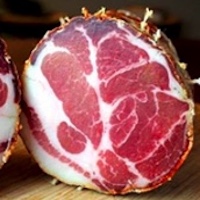Effect of production process and high-pressure processing on viability of Salmonella spp. in traditional Italian dry-cured coppa

Accepted: 8 January 2020
HTML: 27
All claims expressed in this article are solely those of the authors and do not necessarily represent those of their affiliated organizations, or those of the publisher, the editors and the reviewers. Any product that may be evaluated in this article or claim that may be made by its manufacturer is not guaranteed or endorsed by the publisher.
Authors
The aim of the study was to investigate the combined effect of the manufacturing process followed by HPP treatment on the inactivation of Salmonella spp. in artificially contaminated coppa samples, in order to verify the ability of the combined processes to achieve the objective of a 5-log reduction of Salmonella spp. needed for exportation to the U.S. Fresh anatomical cuts intended for coppa production were supplied by four different delicatessen factories located in Northern Italy. Raw meat underwent experimental contamination with Salmonella spp. using a mixture of 3 strains. Surface contamination of the fresh anatomical cuts was carried out by immersion into inoculum containing Salmonella spp. The conditions of the HPP treatment were: pressure 593 MPa, time 290 seconds, water treatment temperature 14°C. Surface and deep samples were performed post contamination (T0), end of the cold phase (T1), end of process (Tend), and after HPP treatment (postHPP) and Salmonella spp. Enumerated. The results of this study show a significant reduction of Salmonella spp. all through the production process (P<0.01) for all companies, followed by an additional reduction of bacterial counts due to HPP treatment (P<0.01), both in superficial and deep contaminations (P<0.01). The superficial overall reduction resulted of 1.58 to 5.04 log CFU/g during the production process. HPP treatment resulted in a significant (P<0.01) superficial and deep decrease in Salmonella spp. enumeration varying from 0.61 to 4.01 log and from 1.49 to 4.13 log. According to the data presented in this study, only the combined approach of coppa manufacturing process followed by HPP treatment always led to a 5-log reduction of Salmonella spp. required by USDA/FSIS guidelines.
How to Cite
PAGEPress has chosen to apply the Creative Commons Attribution NonCommercial 4.0 International License (CC BY-NC 4.0) to all manuscripts to be published.

 https://doi.org/10.4081/ijfs.2020.8445
https://doi.org/10.4081/ijfs.2020.8445



